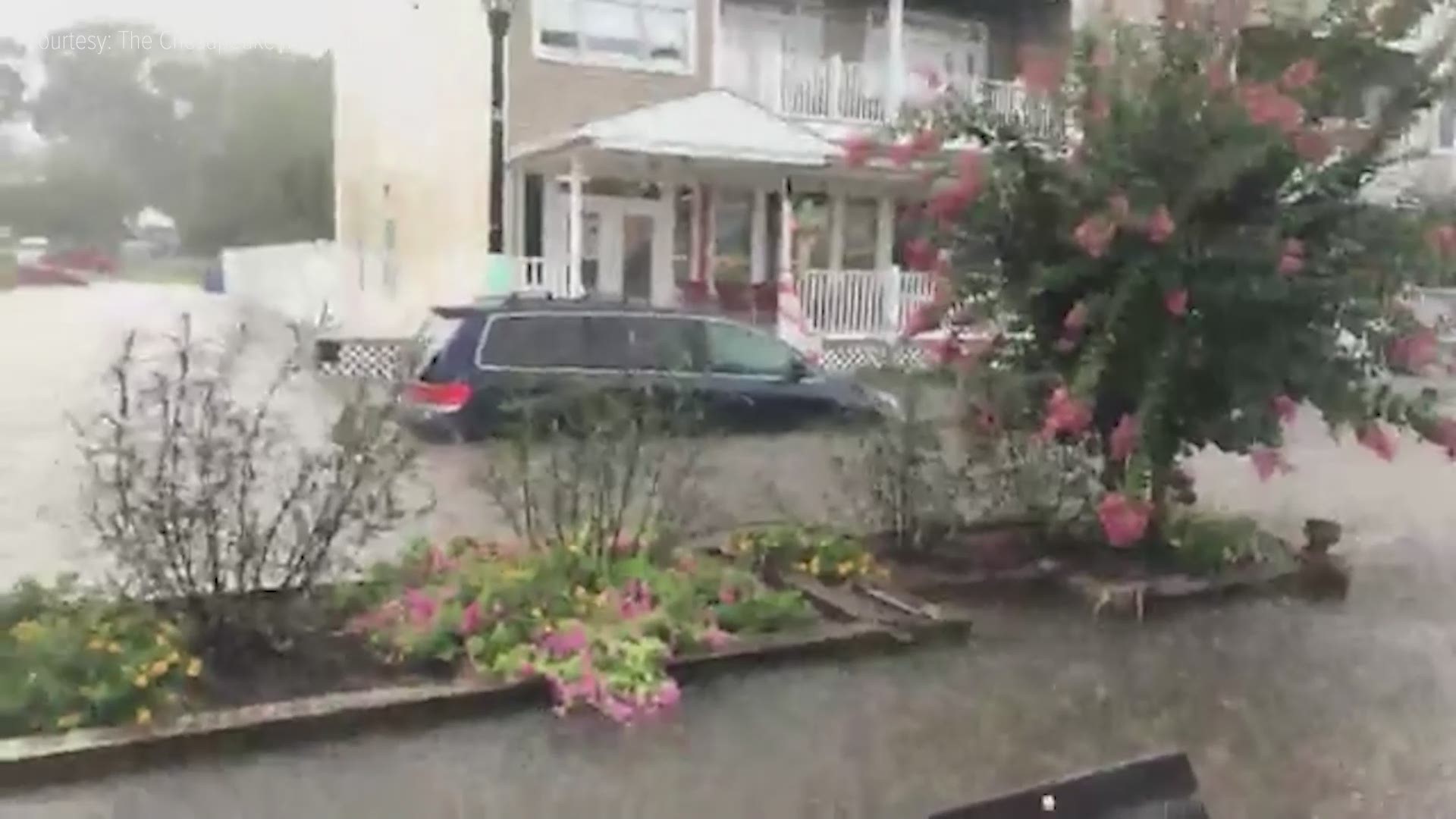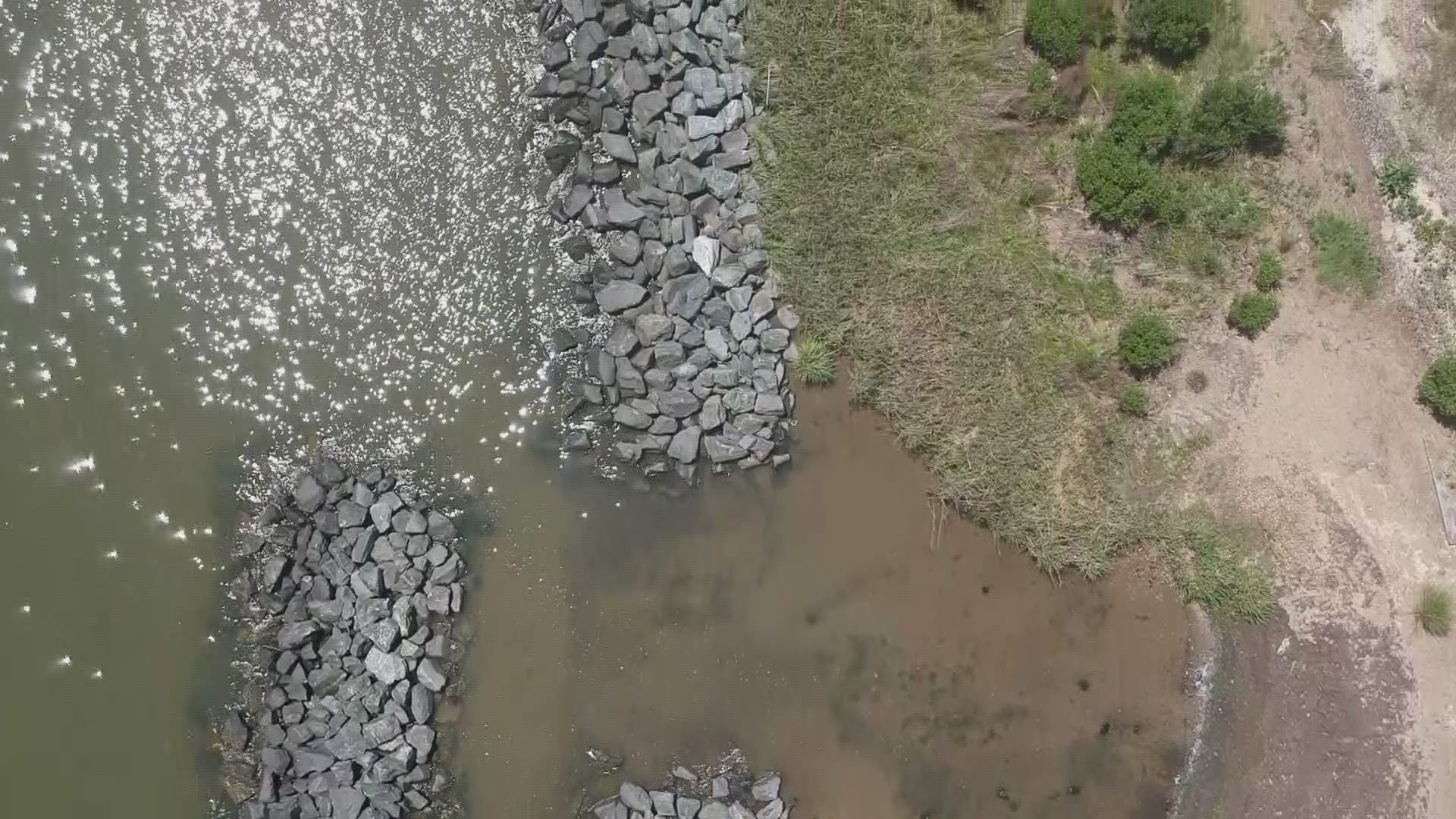NORTH BEACH, Md. — Dale Thomas has owned an antique shop in North Beach, Md. for 50 years. He’s seen countless people, businesses, and summers come and go. He’s also seen the floodwaters come and go.
“We had [weather] warnings from the weather bureau. We lifted carpets and moved stuff around and [we] made preparations. That occurred two or three times every year.”
The street his shop on floods several times a year. Luckily for him, he’s only had to directly deal with flooding in his store one time--during the historic damage caused by Hurricane Isabel in 2003.
“The woman I bought the building from had it for 35 years. She shook her head and said it never flooded, 'Well, I can't say it doesn’t flood,’ Thomas said.
The year 2003 changed that, but for Thomas, that was, “just the one.”
In coastal communities like North Beach, flooding is nothing new. In fact, it’s just a part of life.
The Mayor of North Beach, Mike Benton, a North Beach native, gave us a quick history lesson of flooding in the area.
“I can go back to 1970. And tell you it was flooding. Even back to the incorporation, the town was flooding. If you look at the elevation, look at the bay right there,” Benton gestured. “Yeah, we're below sea level.”
What’s new is the frequency of flooding, especially over the last few decades.
Sea Level Rise and Downpours
A report from the National Oceanic and Atmospheric Administration (NOAA) said sunny-day flooding is on the rise, with places like Annapolis and D.C. expected to more than triple the amount of flooding in 2030 compared to the year 2000. According to NOAA, sunny-day flooding is flooding caused by unusually high tides.


“[In] earlier years, [the floods] might have been once or twice a year,” said Don Bowen, Director of the North Beach Public Works. “But last three years I'd say that it seems like you don't get a normal thunderstorm anymore.”
According to Bowen, the ground saturates much quicker than usual, due to a high-water table, high-tides, and the apparent increase in downpours.
“Rainfall frequency has definitely changed,” Bowen added.
Data from NOAA shows that downpours, or single-day heavy rain events, have been increasing since the late 1900s.
On a sunny day in late May, Bowen took us down to the beach, which was set to be packed after COVID-19 shutdowns, limited who could enjoy these beaches in 2020.
“Where you're looking were looking south, you would have seen at the second [to] third set of pilons here, Bowen said while pointing straight across to the rocks by the water.
Years ago, the pilons Bowen mentioned marked where the Chesapeake Bay ended, and the beach began. Now, the beach is pushed back several dozen feet toward the town. As a result, fewer residents and visitors can enjoy the beach.
“And that would be another 150-feet of beach for residents and guests to sit on that we have lost from beach erosion,” Bowen explained.
So What Can Be Done?
In North Beach, local and state officials have initiated numerous projects to mitigate flooding and beach erosion. One thing was to fix piping that couldn't handle the downpours impacting the town. Additionally, town officials added more pumps to flood-prone areas to drain floodwaters quicker.
Bowen showed us the new faster draining system that was recently put into place.
“We put a 12-inch pipe that goes right into the eight-foot diameter pipe. Now, we're hoping when it rains, when that pipe starts getting filled up, we don't have to wait for it to come over here gravity-wise," Bowen said. We're pulling right out of the large conduit which holds all. It's kind of like a wet well storage for the stormwater.”
Before the new piping and pumps were installed, floodwaters would rush down through the middle of town toward the beach area. Often the floodwaters would remain for hours before draining into the Chesapeake Bay.
Additionally, some local roads have been raised, including State Highway 261, a key evacuation route out of town. A berm, which is a flat layer of sand that is set above high tide level, has been put in place along the beach to slow down erosion. Finally, a living shore has been erected north of town to help reduce beach erosion and flooding. A living shoreline is an alternative method to human-made structures to stabilize eroding shores.


The Battle Rages Along the Atlantic Shoreline
Along the Atlantic shore, what drives eroding beaches are big storms. State and federal officials are in a never-ending fight with the ocean to replace lost sand on popular beaches. Limited sand supply makes it difficult for governments to keep beaches stocked when big storms do hit. In nearby Delaware, the state government has taken charge in the battle against our ever-changing coastline.
Michael Powell, an environmental scientist with the Delaware Department of Natural Resources shared some interesting points about this fight against our coastline.
“We live in an era of sea-level rise,” Powell said. “Centuries of sea-level rise, thousands of years of sea-level rise. As the ocean rises, the beach would like to move back to kind of accommodate that higher ocean level that we see year after year, decade after decade, century after century. The normal response of a sandy coastline to rising sea level is to retreat. But we've built houses and infrastructure up and down our coast. So there's really no room for the beaches and dunes to retreat, as you would see in a place like Assateague Island [Maryland].”
Like Maryland and Virginia, beach communities in Delaware are dealing with beach erosion and coastal flooding. This has meant trouble for nearby Rehoboth Beach and Bethany Beach.
“When we build structures along the coast in a way that blocks the natural flow of sand, it can have impacts on adjacent beaches,” Powell said.
This is happening on beaches up and down the Delaware and Maryland coast. In places like Indian River Inlet and Ocean City Inlet, human-made structures like jetties protect the inlet but stop natural sand transport.
“Large rock jetties have been built to kind of hold those stabilize those inlets and they do a wonderful job of that they keep the inlet from choking with sand. They hold the navigational channel in place and keep it flowing.” Powell added. “But those rock jetties block the flow of sand from moving north and south along the coast in those areas."
Blocking the movement of sand causes some beaches to erode faster than others.
The Chesapeake Bay And Its Unique Problem
The Chesapeake Bay region has a problem that is unique. It’s a problem other coastal regions do not have to deal with: Sinking land.
Erika Lentz, a geologist with the U.S. Geological Survey broke it down.
“Storms are the real change drivers on the Atlantic seaboard,” Lentz said. "[Along with] sea-level rise and the sediment migration. As you move into the Bay, that is where you really get the subsidence and ecosystem and wetland migration change elements.”
That subsidence means the land around the bay is slowly sinking.
The sinking, “is really due to two factors,” Lentz said.
There is groundwater withdrawal. Water sources to homes are actually lowering the reservoir underground and it's causing the land to sink. Combine that with subsidence due to the ice. It's called a glacial isostatic adjustment. Basically, the land is sinking with respect to the last glaciation.
This means there is an “amplified relative sea-level rise” in the Chesapeake Bay region. Cities and towns along the bay are slowly sinking while sea levels continue to rise due to natural and human-made climate change.
Beach cities like North Beach deal with the triple threat of sinking land, increased downpours, and sea-level rise.
“We're trying to be ahead of the curve here. But Mother Nature is going to do a mother nature wants to do, right? And that's what we're combating right now,” said North Beach Mayor Benton.
It’s an immense challenge. But everyone I spoke to seems to be up for the test.
“I have faith in humankind,” Lentz said. “We are going to wrestle with these hard problems and find a way forward. There's a lot that we can do. And there's a lot that we've been faced with in the past that we've already wrestled with. So I have hope for the future.”



